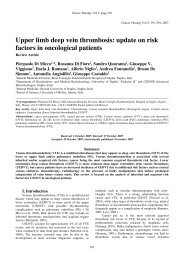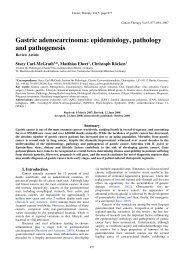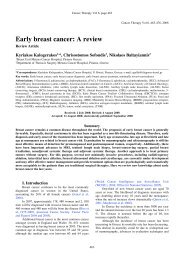Description of a case report of an intestinal-type ... - Cancer Therapy
Description of a case report of an intestinal-type ... - Cancer Therapy
Description of a case report of an intestinal-type ... - Cancer Therapy
You also want an ePaper? Increase the reach of your titles
YUMPU automatically turns print PDFs into web optimized ePapers that Google loves.
Longo et al: <strong>Description</strong> <strong>of</strong> a <strong>case</strong> <strong>report</strong> <strong>of</strong> <strong>an</strong> <strong>intestinal</strong>-<strong>type</strong> mucinous borderline ovari<strong>an</strong> tumor<br />
Surgery is the cornerstone in the m<strong>an</strong>agement <strong>of</strong><br />
BOTs, but m<strong>an</strong>y issues exist on the extent <strong>of</strong> the staging<br />
procedure <strong>an</strong>d the optimal surgical approach, including the<br />
use <strong>of</strong> laparoscopy, conservative surgery, <strong>an</strong>d<br />
retroperitoneal lymph nodes dissection. Considering the<br />
clinical relev<strong>an</strong>ce <strong>of</strong> the stage in deciding treatment<br />
options, a careful inspection <strong>of</strong> the entire abdominal cavity<br />
with peritoneal washing, infracolic omentectomy, removal<br />
<strong>of</strong> all macroscopic suspicious peritoneal lesions, multiple<br />
peritoneal biopsies, <strong>an</strong>d, for MBOTs, appendectomy, are<br />
m<strong>an</strong>datory (Cadron et al, 2007). Unfortunately, complete<br />
staging is only performed in 50% or fewer patients, even<br />
though the pelvic peritoneum <strong>an</strong>d abdominal peritoneum<br />
are involved in 58% <strong>an</strong>d 48% <strong>of</strong> patients, respectively<br />
(Menzin et al, 2000; Cadron et al, 2007). Furthermore,<br />
invasive impl<strong>an</strong>ts are present in pelvic peritoneum <strong>an</strong>d<br />
abdominal peritoneum in 9% <strong>an</strong>d 14% <strong>of</strong> patients,<br />
respectively. The omentum is involved in 39% <strong>of</strong> patients,<br />
<strong>an</strong>d in 9% <strong>of</strong> patients, these impl<strong>an</strong>ts are invasive (Jones,<br />
2006; Cadron et al, 2007).<br />
Because younger women are more likely to develop<br />
BOTs, <strong>an</strong> import<strong>an</strong>t issue is the appropriateness <strong>of</strong><br />
conservative surgery with fertility preservation for stage I<br />
disease or for BOTs with noninvasive impl<strong>an</strong>ts. According<br />
to results <strong>of</strong> retrospective studies comparing conservative<br />
vs more radical approach, it seems reasonable to perform<br />
conservative surgery (ie, salpingo-oophorectomy with<br />
infracolic omentectomy <strong>an</strong>d multiple peritoneal biopsies<br />
<strong>an</strong>d cytology) only for stage I disease (Cadron et al,<br />
2007).Considering the increased risk <strong>of</strong> developing<br />
persistent invasive impl<strong>an</strong>ts or recurrence, patients with<br />
invasive impl<strong>an</strong>ts should be treated with radical surgery.<br />
In <strong>case</strong> <strong>of</strong> extraovari<strong>an</strong> recurrence with invasive impl<strong>an</strong>ts<br />
after conservative therapy, extensive cytoreductive surgery<br />
remains the treatment option <strong>of</strong> choice (Cadron et al,<br />
2007). The adv<strong>an</strong>tage <strong>of</strong> retroperitoneal lymph node<br />
sampling is questionable in patients with BOTs <strong>an</strong>d<br />
lymphadenectomy c<strong>an</strong> be omitted, even for the adv<strong>an</strong>ced<br />
disease, because it does not affect the recurrence or<br />
survival rate (Cho et al, 2006; Cadron et al, 2007). A<br />
recent prospective study conducted in 57 women with<br />
BOTs, para-aortic <strong>an</strong>d pelvic node dissection was not<br />
correlated to <strong>an</strong>y survival adv<strong>an</strong>tage (Pirimoglu et al,<br />
2008).<br />
Laparoscopy seems to be feasible in BOTs <strong>of</strong><br />
moderate size (diameter below 10 cm), to give fewer<br />
complications <strong>an</strong>d a shorter hospitalization (Cadron et al,<br />
2007; Daraï et al, 2007; Ødegaard et al, 2007). However,<br />
m<strong>an</strong>y potential concerns remain unmet, including the<br />
ch<strong>an</strong>ce <strong>of</strong> tumor rupture, the development <strong>of</strong> port site<br />
metastases, <strong>an</strong>d finally a potentially increased number <strong>of</strong><br />
patients with unstaged or inappropriately staged tumors.<br />
Future, prospective studies with a long-term follow-up are<br />
needed to determine the ultimate recurrence risk as well as<br />
fertility rates <strong>of</strong> this procedure as compared to laparotomy<br />
(Cadron et al, 2007).<br />
Chemotherapy should be reserved only for<br />
progressive disease that does not respond to surgical<br />
m<strong>an</strong>agement (Cadron et al, 2007).<br />
Finally, <strong>an</strong>other import<strong>an</strong>t issue is the intraoperative<br />
frozen section (IFS) diagnosis <strong>of</strong> BOTs. A recent<br />
retrospective <strong>an</strong>alysis comparing IFS <strong>an</strong>alysis <strong>an</strong>d<br />
definitive histology showed <strong>an</strong> agreement between these<br />
two procedures in 69/96 (71.9%) patients, yielding <strong>an</strong><br />
overall sensitivity <strong>an</strong>d a positive predictive value <strong>of</strong> 75.0%<br />
<strong>an</strong>d 94.5%, respectively. Underdiagnosis <strong>an</strong>d<br />
overdiagnosis occurred in 27/96 (28%) <strong>an</strong>d 0/96 (0%)<br />
patients, respectively. The authors concluded that surgical<br />
m<strong>an</strong>agement based on IFS diagnosis should be used with<br />
caution in BOT patients (Tempfer et al, 2007).<br />
In our <strong>case</strong>, considering tumor dimensions, the<br />
menopausal status <strong>an</strong>d the lack <strong>of</strong> peritoneal impl<strong>an</strong>ts <strong>an</strong>d<br />
locoregional lymph nodes involvement, the patient<br />
underwent radical surgical tumor resection without other<br />
adjuv<strong>an</strong>t treatments. After a follow up <strong>of</strong> 19 months, the<br />
patient is alive, in good clinical conditions, <strong>an</strong>d diseasefree<br />
References<br />
Acs G (2005) Serous <strong>an</strong>d mucinous borderline (low malign<strong>an</strong>t<br />
potential) tumors <strong>of</strong> the ovary. Am J Clin Pathol<br />
123(Suppl), S13-S57.<br />
Cadron I, Leunen K, V<strong>an</strong> Gorp T, Am<strong>an</strong>t F, Neven P, Vergote I<br />
(2007) M<strong>an</strong>agement <strong>of</strong> borderline ovari<strong>an</strong> neoplasms. J Clin<br />
Oncol 25, 2928-37.<br />
Cho YH, Kim DY, Kim JH, Kim YM, Kim KR, Kim YT, Nam<br />
JH (2006) Is complete surgical staging necessary in patients<br />
with stage I mucinous epithelial ovari<strong>an</strong> tumors? Gynecol<br />
Oncol 103, 878-82.<br />
Daraï E, Tulpin L, Prugnolle H, Cortez A, Dubernard G (2007)<br />
Laparoscopic restaging <strong>of</strong> borderline ovari<strong>an</strong> tumors. Surg<br />
Endosc 21, 2039-43.<br />
Guerrieri C, Hogberg T, Wingren S, Fristedt S, Simonsen E,<br />
Boeryd B (1994) Mucinous borderline <strong>an</strong>d malign<strong>an</strong>t tumors<br />
<strong>of</strong> the ovary. A clinicopathologic <strong>an</strong>d DNA ploidy study <strong>of</strong><br />
92 <strong>case</strong>s. C<strong>an</strong>cer 74, 2329-40.<br />
Hart WR (2005a) Borderline epithelial tumors <strong>of</strong> the ovary. Mod<br />
Pathol 18(Suppl 2), S33-S50.<br />
Hart WR (2005b) Mucinous tumors <strong>of</strong> the ovary: a review. Int J<br />
Gynecol Pathol 24, 4-25.<br />
Jones MB (2006) Borderline ovari<strong>an</strong> tumors: current concepts for<br />
prognostic factors <strong>an</strong>d clinical m<strong>an</strong>agement. Clin Obstet<br />
Gynecol 49,517-25.<br />
Kaern J, Tropé CG, Abeler VM (1993) A retrospective study <strong>of</strong><br />
370 borderline tumors <strong>of</strong> the ovary treated at the Norwegi<strong>an</strong><br />
Radium Hospital from 1970 to 1982: a review <strong>of</strong><br />
clinicopathologic features <strong>an</strong>d treatment modalities. C<strong>an</strong>cer<br />
71, 1810-20.<br />
Kikkawa F, Nawa A, Kajiyama H, Shibata K, Ino K, Nomura S<br />
(2006) Clinical characteristics <strong>an</strong>d prognosis <strong>of</strong> mucinous<br />
tumors <strong>of</strong> the ovary. Gynecol Oncol 103, 171-5.<br />
Klim<strong>an</strong> L, Rome RM, Fortune DW (1986) Low malign<strong>an</strong>t<br />
potential tumors <strong>of</strong> the ovary: a study <strong>of</strong> 76 <strong>case</strong>s. Obstet<br />
Gynecol 68, 338-44.<br />
Lee KR, Scully RE (2000) Mucinous tumors <strong>of</strong> the ovary: a<br />
clinicopathologic study <strong>of</strong> 196 borderline tumors (<strong>of</strong><br />
<strong>intestinal</strong> <strong>type</strong>) <strong>an</strong>d carcinomas, including <strong>an</strong> evaluation <strong>of</strong><br />
11 <strong>case</strong>s with “pseudomyxoma peritonei”. Am J Surg<br />
Pathol 24, 1447-64.<br />
Ludwick CL, Gilks CB, Miller D, Yaziji H, Clement PB (2005)<br />
Aggressive behavior <strong>of</strong> stage 1 ovari<strong>an</strong> mucinous tumors<br />
lacking extensive infiltrative invasion: a <strong>report</strong> <strong>of</strong> four <strong>case</strong>s<br />
<strong>an</strong>d review <strong>of</strong> the literature. Int J Gynecol Pathol 24, 205-<br />
17.<br />
1008







